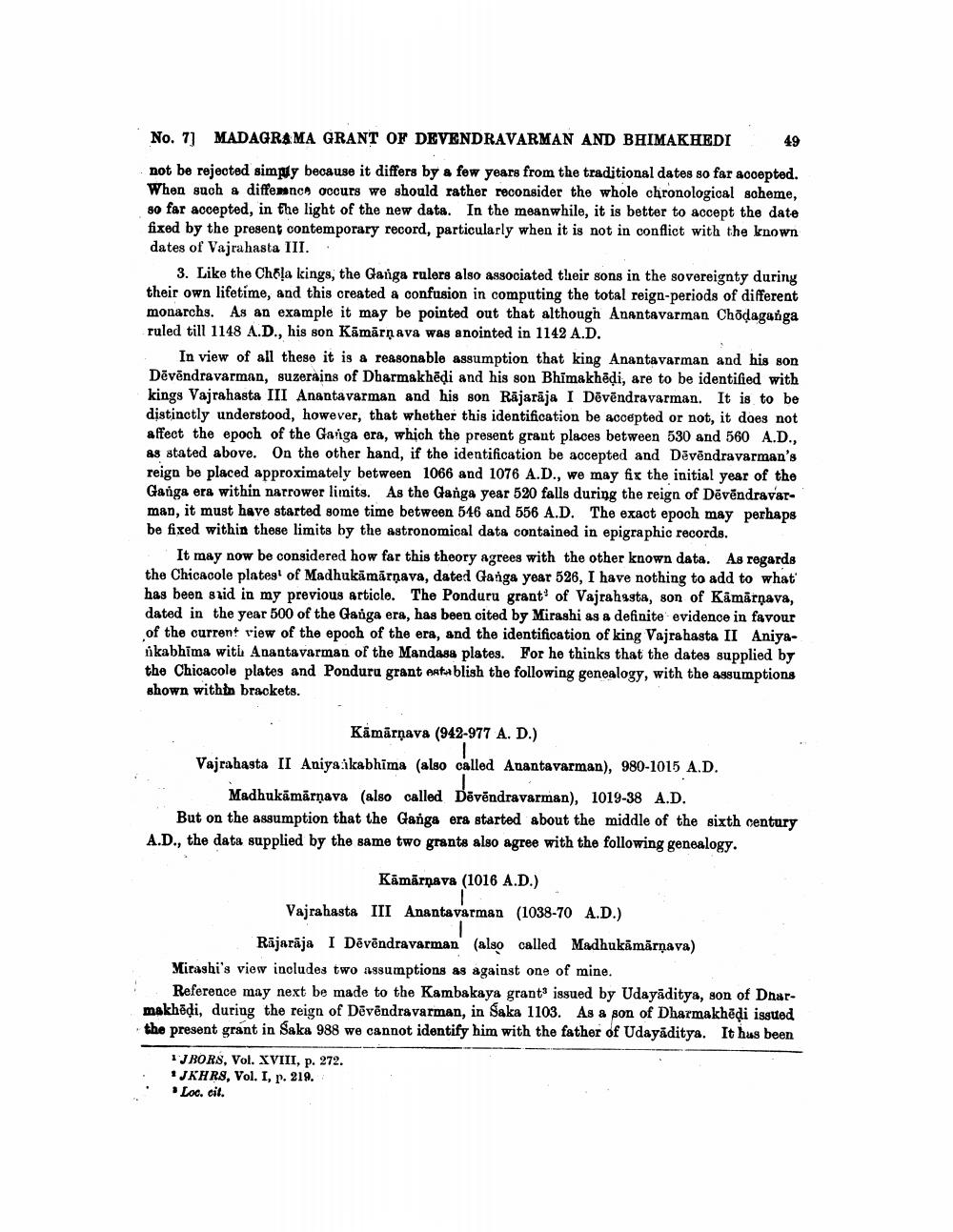________________
No. 7] MADAGRAMA GRANT OF DEVENDRAVARMAN AND BHIMAKHEDI
not be rejected simply because it differs by a few years from the traditional dates so far accepted. When such a difference occurs we should rather reconsider the whole chronological scheme, so far accepted, in the light of the new data. In the meanwhile, it is better to accept the date fixed by the present contemporary record, particularly when it is not in conflict with the known dates of Vajrahasta III.
3. Like the Chola kings, the Ganga rulers also associated their sons in the sovereignty during their own lifetime, and this created a confusion in computing the total reign-periods of different monarchs. As an example it may be pointed out that although Anantavarman Chōḍaganga ruled till 1148 A.D., his son Kāmārṇava was anointed in 1142 A.D.
In view of all these it is a reasonable assumption that king Anantavarman and his son Devendravarman, suzerains of Dharmakhedi and his son Bhimakhēḍi, are to be identified with kings Vajrahasta III Anantavarman and his son Rajaraja I Dēvēndravarman. It is to be distinctly understood, however, that whether this identification be accepted or not, it does not affect the epoch of the Ganga era, which the present grant places between 530 and 560 A.D., as stated above. On the other hand, if the identification be accepted and Devendravarman's reign be placed approximately between 1066 and 1076 A.D., we may fix the initial year of the Ganga era within narrower limits. As the Ganga year 520 falls during the reign of Devendravarman, it must have started some time between 546 and 556 A.D. The exact epoch may perhaps be fixed within these limits by the astronomical data contained in epigraphic records.
It may now be considered how far this theory agrees with the other known data. As regards the Chicacole plates' of Madhukämarnava, dated Ganga year 526, I have nothing to add to what' has been said in my previous article. The Ponduru grant of Vajrahasta, son of Kämärņava, dated in the year 500 of the Ganga era, has been cited by Mirashi as a definite evidence in favour of the current view of the epoch of the era, and the identification of king Vajra hasta II Aniyakabhima with Anantavarman of the Mandasa plates. For he thinks that the dates supplied by the Chicacole plates and Ponduru grant establish the following genealogy, with the assumptions shown within brackets.
Kämärṇava (942-977 A. D.) T
Vajrahasta II Aniya ikabhima (also called Anantavarman), 980-1015 A.D.
49
Madhukāmārṇava (also called Devendravarman), 1019-38 A.D.
Devendrav
But on the assumption that the Ganga era started about the middle of the sixth century A.D., the data supplied by the same two grants also agree with the following genealogy.
Kāmārņava (1016 A.D.) T
Vajrahasta III Anantavarman (1038-70 A.D.)
I
Rājarāja I Dēvēndravarman (also called Madhukamārṇava)
Mirashi's view includes two assumptions as against one of mine.
Reference may next be made to the Kambakaya grant issued by Udayaditya, son of Dnarmakhedi, during the reign of Devendravarman, in Saka 1103. As a son of Dharmakhedi issued the present grant in Saka 988 we cannot identify him with the father of Udayaditya. It has been
JBORS, Vol. XVIII, p. 272.
JKHRS, Vol. I, p. 219.
Loc. cit.




